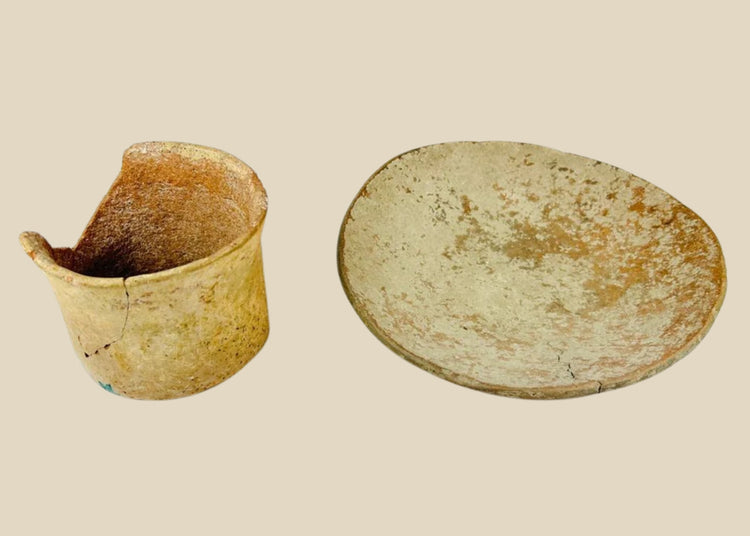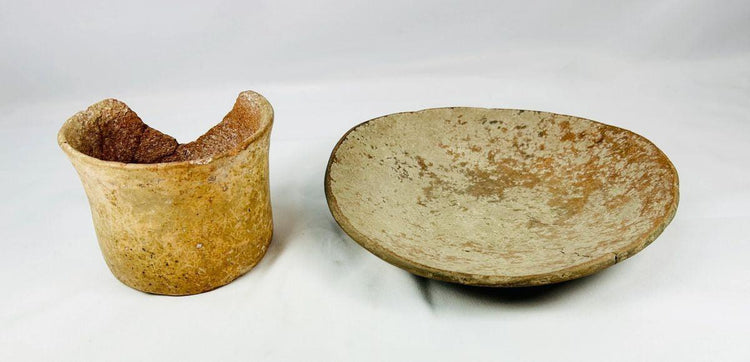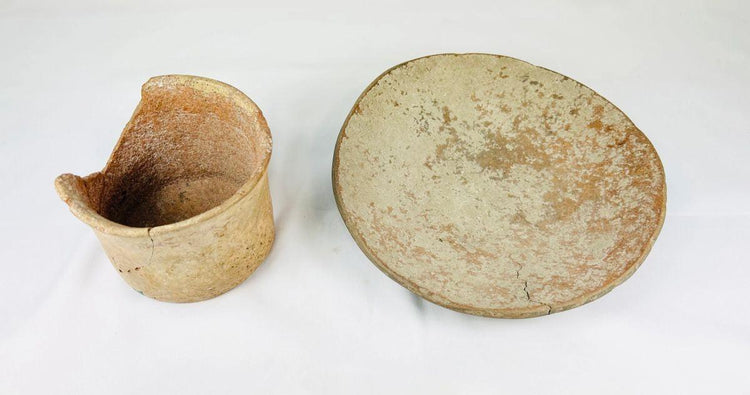Neolithic Pottery Bowl and Vessel Fragment Set | Circa 4000–2000 BCE
Description
More
Less
Historical Context & Origin
Region: Likely Europe, the Middle East, or North Africa
Material: Hand-formed terracotta (unglazed pottery)
Period: Neolithic Period, circa 4000–2000 BCE
Description
This remarkable set of Neolithic pottery consists of two significant pieces: a shallow bowl and a partially intact cylindrical vessel fragment. Both objects exemplify the ingenuity and craftsmanship of early agricultural societies during the transition from nomadic to settled lifestyles. The bowl’s rounded form suggests use in food preparation or serving, while the vessel’s cylindrical structure may have been intended for storage, ritual use, or as an urn. Together, they represent the essential role of pottery in daily and ceremonial life during the Neolithic era.
Features
- Handmade construction, showcasing early human pottery techniques
- Natural earthy tones with surfaces unglazed, typical of Neolithic ware
- Shallow bowl designed for food preparation or serving
- Cylindrical vessel fragment possibly used for storage, ritual, or funerary practices
- Both pieces display natural weathering and patina developed over millennia
Cultural Significance
Pottery was a vital innovation of the Neolithic period, reflecting the shift from nomadic lifestyles to agricultural settlement. These vessels provided durable means of storage, preparation, and ritual use, marking an essential step in human development. Such artifacts not only served practical purposes but also embodied spiritual and ceremonial aspects of early life, offering insight into the beliefs and daily practices of prehistoric communities.
Condition
Both pieces exhibit surface wear, minor abrasions, and natural patina consistent with great age. Despite their fragmentary state, they remain highly evocative examples of Neolithic craftsmanship and daily life.
Dimensions (approximate)
Bowl:
Diameter: 9 in
Vessel Fragment:
Height: 5 in
Width: 3.5 in
Age
Circa 4000–2000 BCE
Learn More
Explore the Neolithic period and the origins of pottery, agriculture, and early settled life: Learn About the Neolithic Period
Discover ancient ceramic and pottery artifacts from early civilizations: Explore Ancient Ceramics & Pottery
Description
Historical Context & Origin
Region: Likely Europe, the Middle East, or North Africa
Material: Hand-formed terracotta (unglazed pottery)
Period: Neolithic Period, circa 4000–2000 BCE
Description
This remarkable set of Neolithic pottery consists of two significant pieces: a shallow bowl and a partially intact cylindrical vessel fragment. Both objects exemplify the ingenuity and craftsmanship of early agricultural societies during the transition from nomadic to settled lifestyles. The bowl’s rounded form suggests use in food preparation or serving, while the vessel’s cylindrical structure may have been intended for storage, ritual use, or as an urn. Together, they represent the essential role of pottery in daily and ceremonial life during the Neolithic era.
Features
- Handmade construction, showcasing early human pottery techniques
- Natural earthy tones with surfaces unglazed, typical of Neolithic ware
- Shallow bowl designed for food preparation or serving
- Cylindrical vessel fragment possibly used for storage, ritual, or funerary practices
- Both pieces display natural weathering and patina developed over millennia
Cultural Significance
Pottery was a vital innovation of the Neolithic period, reflecting the shift from nomadic lifestyles to agricultural settlement. These vessels provided durable means of storage, preparation, and ritual use, marking an essential step in human development. Such artifacts not only served practical purposes but also embodied spiritual and ceremonial aspects of early life, offering insight into the beliefs and daily practices of prehistoric communities.
Condition
Both pieces exhibit surface wear, minor abrasions, and natural patina consistent with great age. Despite their fragmentary state, they remain highly evocative examples of Neolithic craftsmanship and daily life.
Dimensions (approximate)
Bowl:
Diameter: 9 in
Vessel Fragment:
Height: 5 in
Width: 3.5 in
Age
Circa 4000–2000 BCE
Learn More
Explore the Neolithic period and the origins of pottery, agriculture, and early settled life: Learn About the Neolithic Period
Discover ancient ceramic and pottery artifacts from early civilizations: Explore Ancient Ceramics & Pottery
You May Also Like























